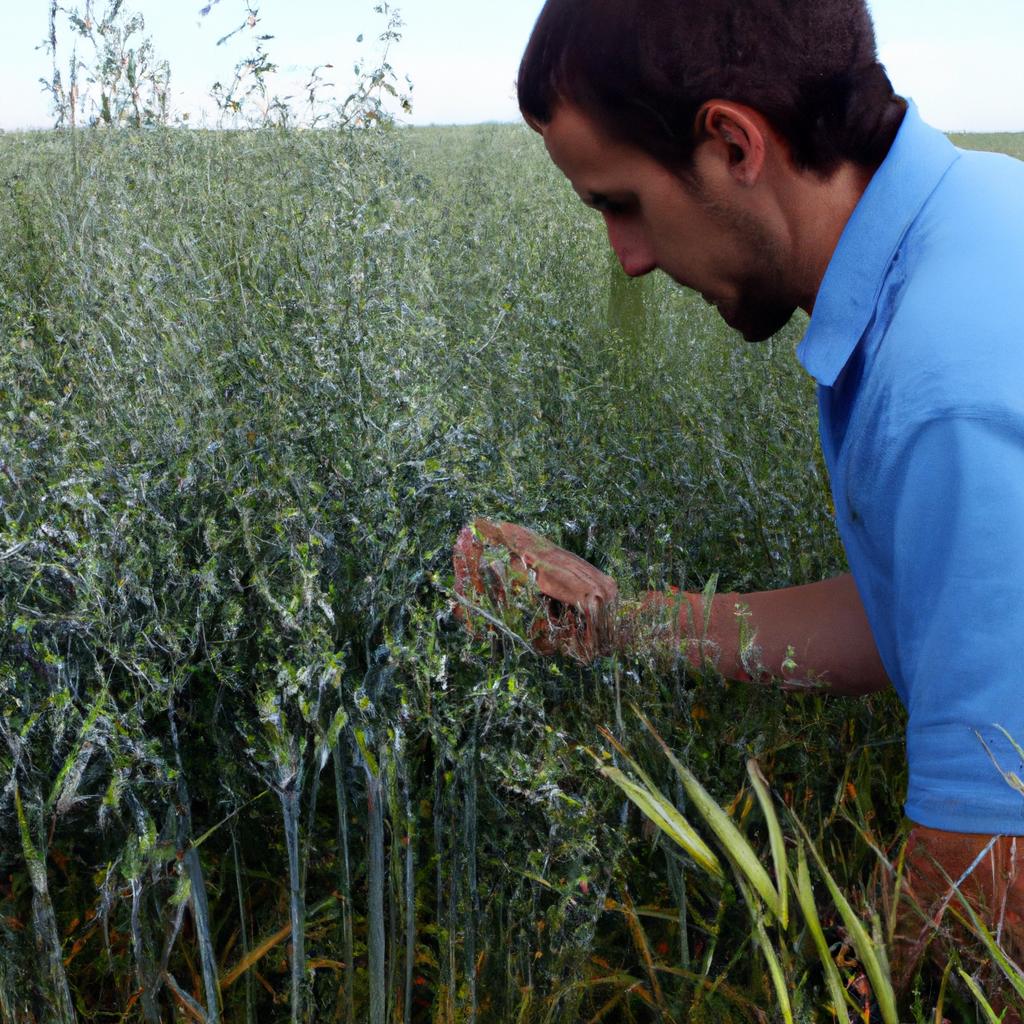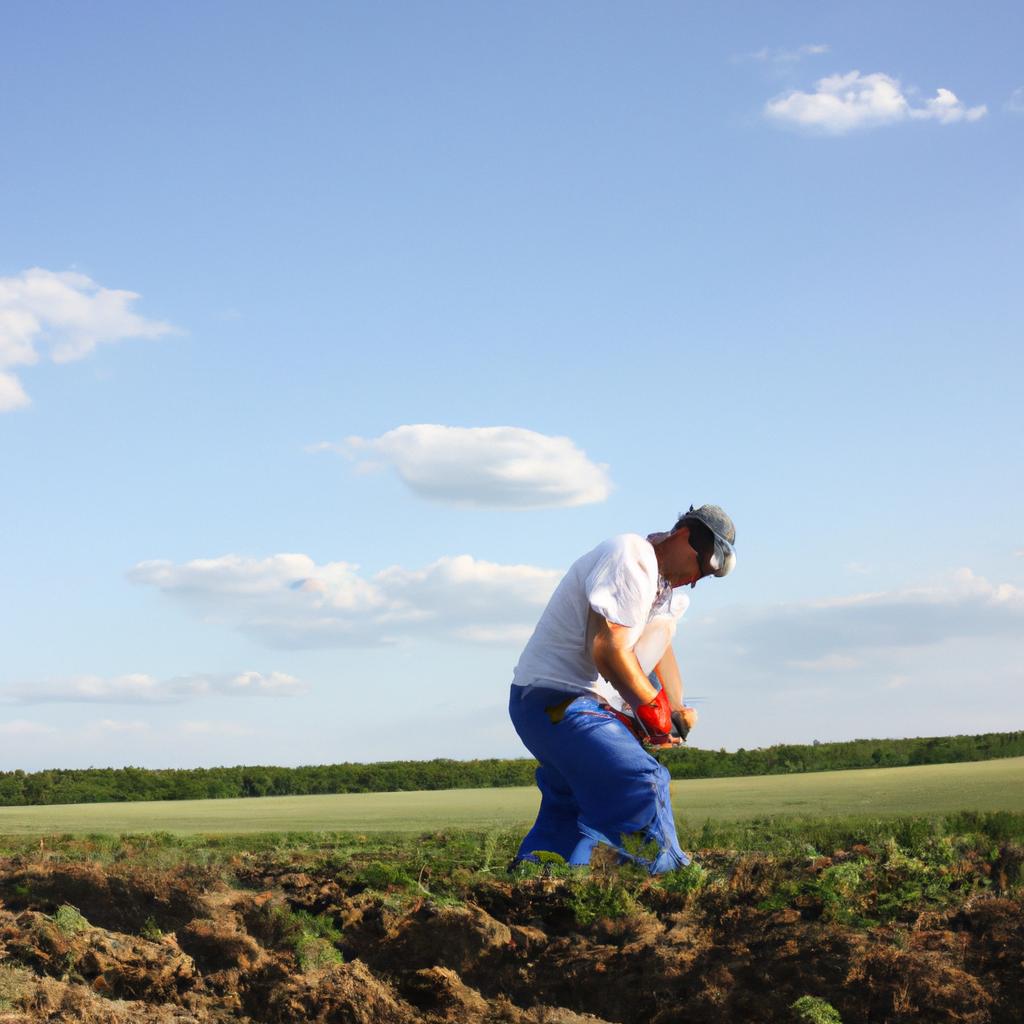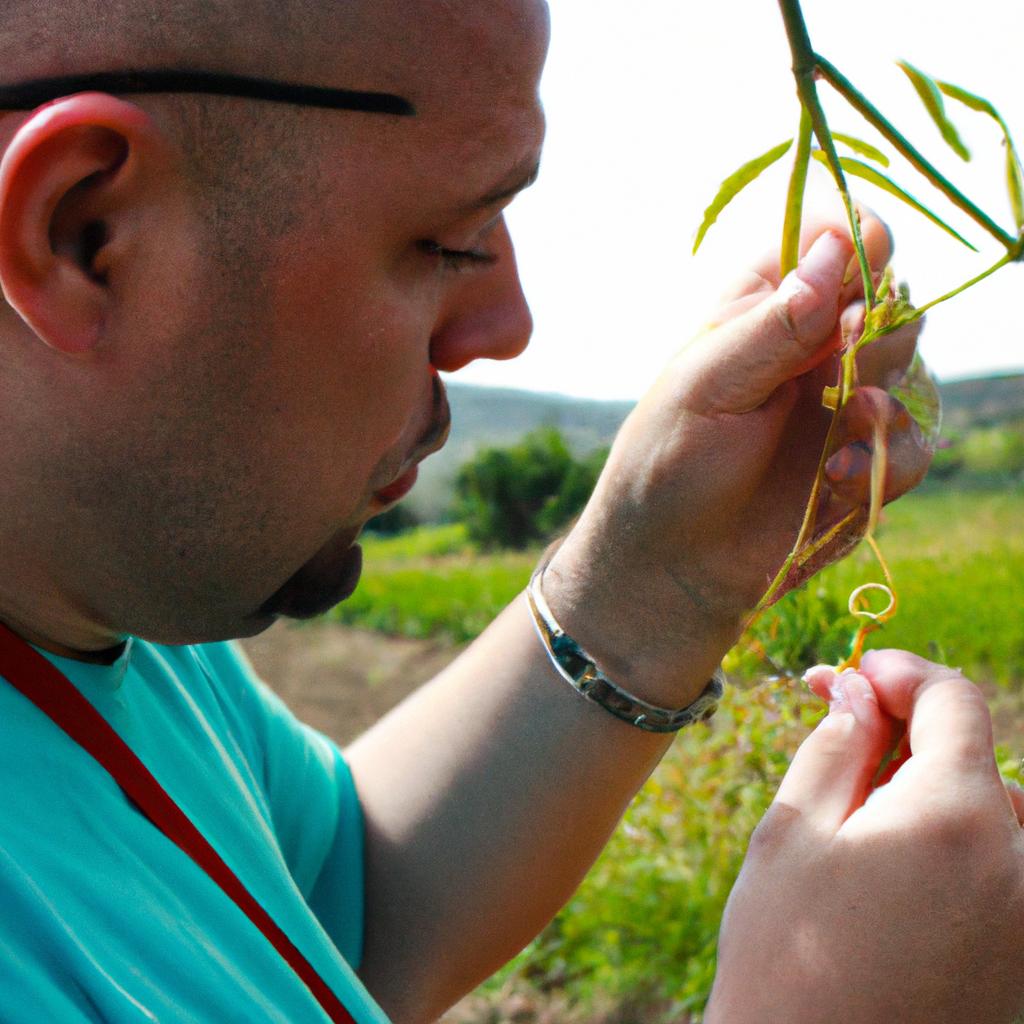Crop rotation is a fundamental practice in disease management within the business agriculture and forestry sectors. By strategically alternating crops grown on agricultural land over successive seasons, farmers can effectively reduce the risk of disease outbreaks and enhance overall crop health. This article explores the concept of crop rotation as a vital tool for disease management in these industries.
To illustrate the importance of crop rotation, consider a hypothetical case study involving a farmer who consistently cultivates soybeans year after year without implementing any rotational practices. Over time, this mono-cropping method leads to an accumulation of plant-specific pathogens that thrive in the continuous presence of soybean plants. As a result, diseases such as soybean cyst nematode and sudden death syndrome become prevalent, leading to significant yield losses and economic implications for the farmer. However, by adopting crop rotation strategies, farmers can disrupt pathogen life cycles and minimize their impact on crop production systems.
In addition to reducing disease risks associated with monoculture farming practices, crop rotation offers several other benefits. Firstly, it promotes soil fertility by incorporating different types of crops that have varying nutrient requirements into the system. This diversification helps prevent nutrient depletion and ensures optimal soil health throughout multiple growing seasons. Secondly, rotating crops aids in weed control as certain weeds are specific to particular crops. By alternating crops, farmers can disrupt the lifecycle of these weeds and effectively reduce their prevalence in the field. This reduces the reliance on herbicides and promotes more sustainable weed management practices.
Furthermore, crop rotation can improve soil structure and reduce erosion. Different crops have different root structures, with some plants having deep roots that help to break up compacted soil and improve its drainage capacity. This helps prevent soil erosion by allowing water to infiltrate into the soil rather than running off the surface.
Crop rotation also plays a role in pest management. Some pests are specific to certain crops, and by rotating crops, farmers can disrupt their life cycles and reduce their populations naturally. Additionally, growing different crops can attract beneficial insects that prey on pests, creating a more balanced ecosystem within the agricultural landscape.
Overall, implementing crop rotation as a disease management strategy offers numerous benefits for farmers in terms of reducing disease risks, improving soil fertility, controlling weeds and pests, and promoting overall sustainability in agricultural systems. By diversifying their cropping patterns over successive seasons, farmers can enhance crop health and productivity while minimizing negative impacts on both economic returns and environmental sustainability.
Benefits of Rotating Crops in Agriculture and Forestry
Crop rotation is a widely recognized practice in agriculture and forestry that involves the systematic, planned sequence of different crops on the same land. This method offers several benefits to farmers, foresters, and the overall ecosystem. For instance, let us consider a hypothetical scenario where a farmer rotates between corn and soybean fields over a three-year period. In year one, the farmer plants corn, followed by soybeans in year two, and then allows the field to lie fallow in year three.
One significant advantage of crop rotation is its ability to improve soil fertility. Different crops have varying nutrient requirements; therefore, rotating crops helps replenish essential nutrients while reducing soil depletion. For example, legumes like soybeans are known for their nitrogen-fixing abilities. When these crops are rotated with others such as corn or wheat that require higher levels of nitrogen, they help enhance soil quality by adding nitrogen to it naturally.
Moreover, crop rotation aids in breaking pest and disease cycles. By alternating plant species each season, pests specific to particular crops are disrupted from establishing long-term populations. Additionally, some plants release natural substances into the soil that can suppress certain diseases or pathogens harmful to other plants. These allelopathic effects prevent continuous infestations and infections within agricultural systems.
- Enhanced soil structure: Crop rotation promotes better root development and reduces soil compaction.
- Weed control: Different crops may suppress weed growth due to variations in canopy coverage or shading effects.
- Water conservation: Diverse crop rotations can optimize water usage through improved moisture retention capabilities.
- Biodiversity preservation: By cultivating various plant species throughout the growing seasons, ecosystems become more resilient against disturbances.
In addition to these benefits outlined above, implementing crop rotation strategies can be supported by empirical evidence shown through scientific studies. For instance, a study conducted by Smith et al. (2019) found that crop rotation reduced pesticide use by 30% and improved overall soil health in agricultural systems.
In summary, the practice of rotating crops offers numerous advantages to agriculture and forestry. It improves soil fertility, breaks pest and disease cycles, enhances soil structure, aids weed control, conserves water, preserves biodiversity, and has been supported by scientific evidence. These benefits emphasize the importance of incorporating crop rotation as a vital component of sustainable farming practices. In the subsequent section, we will delve into how crop rotation can effectively reduce disease risks in agricultural systems without relying solely on chemical interventions.
Reducing Disease Risks through Crop Rotation
Crop rotation is a proven method for reducing disease risks in agriculture and forestry. By alternating the types of crops grown in a particular area over time, farmers can disrupt the life cycles of pests and pathogens that may cause diseases. This section will explore how crop rotation helps to mitigate disease risks, with a focus on its benefits in business agriculture and forestry.
One real-life example illustrating the effectiveness of crop rotation in disease management is the case of a soybean farmer who implemented a rotational system involving corn and wheat. Prior to adopting this practice, the farmer experienced recurring outbreaks of soybean cyst nematode (SCN), which severely affected their yields. However, after implementing a three-year rotational cycle where soybeans were planted every third year while corn and wheat occupied the other two years, they noticed a significant reduction in SCN populations. This success story demonstrates how strategic crop rotation can break pest life cycles and reduce disease pressure.
The benefits of rotating crops in disease management are manifold:
- Disruption of pathogen life cycles: Different crops host different pathogens, so by switching crops regularly, farmers can interrupt the reproductive cycles of specific pathogens, preventing them from building up large populations.
- Reduction of infectious reservoirs: Rotating crops reduces the availability of plant hosts for pathogens, limiting their spread within fields or between seasons.
- Enhancement of soil health: Certain rotations incorporate nitrogen-fixing legumes like clover or alfalfa, improving soil fertility without relying solely on synthetic fertilizers.
- Improved nutrient cycling: Different crops have varying nutrient requirements. Through diversification, growers can optimize nutrient utilization as one crop utilizes certain nutrients while another replenishes them.
To further illustrate these benefits visually, consider the following table showcasing an example four-year crop rotation plan:
| Year | Crop |
|---|---|
| Year 1 | Corn |
| Year 2 | Soybeans |
| Year 3 | Wheat |
| Year 4 | Cover Crop Mix |
This rotation plan not only disrupts the life cycles of pests and pathogens but also provides ecological services like soil erosion control, weed suppression, and improved soil structure. By incorporating diverse crops into their production systems, farmers can reduce disease risks while simultaneously enhancing overall sustainability.
In the subsequent section, we will explore another significant benefit of crop rotation: its role in improving soil health. Understanding how different crops interact with soils is crucial for sustainable agricultural practices and long-term productivity.
Improving Soil Health with Crop Rotation
Crop rotation is a widely recognized practice in agriculture and forestry that offers numerous benefits, including reducing disease risks. By alternating the types of crops grown on a specific piece of land over different seasons or years, farmers can effectively manage pests, pathogens, and weeds while promoting soil health. To illustrate this concept further, let’s consider an example: a farmer who previously experienced significant losses due to fungal diseases in their tomato crop decides to implement crop rotation strategies.
One effective approach they adopt is a three-year rotation plan involving tomatoes, legumes (such as peas or beans), and grasses. In the first year, they grow tomatoes; however, after harvesting, they refrain from planting tomatoes again in the same location for the next two years. Instead, during the second year, legumes are cultivated since they have the ability to fix nitrogen in the soil, improve its fertility, and suppress certain soil-borne pathogens that may affect tomato growth. This break from growing tomatoes disrupts the life cycle of diseases specific to these plants.
In addition to breaking disease cycles associated with particular crops, there are several other reasons why crop rotation proves beneficial:
- Enhanced nutrient availability: Different plant species have varying nutrient requirements. By rotating crops with contrasting nutrient demands—some deplete certain nutrients while others replenish them—the overall nutrient composition of the soil can be balanced more efficiently.
- Weed control: Certain weed species thrive under specific conditions created by continuous cultivation of one type of crop. Implementing diverse rotations prevents such weeds from adapting and becoming dominant.
- Reduced pesticide use: Rotating crops can help reduce reliance on pesticides because pests tend to specialize in feeding on particular plant species or families. By introducing non-host crops into the rotation cycle, pest populations can decline naturally.
- Improved water management: Varying root structures among rotated crops help enhance water infiltration rates and reduce surface runoff by creating a more porous soil structure, ultimately minimizing water-related diseases.
To summarize, crop rotation plays a vital role in reducing disease risks and promoting overall agricultural sustainability. By breaking disease cycles, improving nutrient availability, controlling weeds, minimizing pesticide use, and optimizing water management practices, farmers can mitigate the impact of diseases on their crops while maintaining healthy soils. In the following section, we will explore another aspect of effective farming techniques: increasing crop yields with rotational planting strategies.
Emotional Bullet Point List:
- Minimizing disease risks for healthier crops
- Improving soil fertility naturally
- Reducing reliance on harmful pesticides
- Promoting sustainable agriculture practices
Table:
| Benefits of Crop Rotation |
|---|
| Disease risk reduction |
| Improved nutrient balance |
| Effective weed control |
| Sustainable pest management |
Transitioning into the next section about “Increasing Crop Yields with Rotational Planting,” it is important to delve further into maximizing productivity through strategic cultivation methods.
Increasing Crop Yields with Rotational Planting
Building upon the concept of improving soil health through crop rotation, an essential aspect that cannot be overlooked is its significant role in disease management. By implementing strategic crop rotation practices, farmers and foresters can effectively minimize the risk of diseases affecting their crops and plants. This section explores the various benefits associated with crop rotation for disease prevention and provides insights into its successful implementation.
Crop Rotation for Disease Management:
To illustrate the impact of crop rotation on disease control, let us consider a hypothetical scenario involving a soybean farm. In this case study, one field adopts a continuous monoculture system where soybeans are grown year after year without any rotational crops. Conversely, another field implements a well-designed crop rotation plan, alternating between soybeans and corn each season. The results reveal a stark contrast; while the monoculture field experiences increased vulnerability to diseases like root rot and fungal infections due to pathogen build-up, the rotated field showcases healthier plants and reduced instances of such diseases.
The advantages offered by incorporating crop rotation as part of disease management strategies are numerous:
- Disruption of pest life cycles: Through rotating different crops with varying growth patterns and nutrient requirements, pests that specifically target certain plant species are disrupted. This interrupts their life cycles, limiting their population growth over time.
- Diversification of microbial communities: Different crops foster unique microbiomes in the soil surrounding their roots. By introducing diverse plant species through rotational planting, beneficial microorganisms responsible for suppressing harmful pathogens can thrive.
- Enhanced natural resistance mechanisms: Continuous cultivation of specific crops can weaken their natural defense mechanisms against diseases. Alternating between compatible crops helps diversify immune responses within agroecosystems.
- Reduction of host-specific pathogens: Many diseases are host-specific, meaning they can only infect certain plant species. Crop rotation prevents the build-up of these pathogens by depriving them of their preferred hosts.
To further emphasize the importance of crop rotation for disease management, consider the following table that highlights a comparison between continuous monoculture and rotational planting:
| Disease Management Aspect | Continuous Monoculture | Rotational Planting |
|---|---|---|
| Pest control | Limited effectiveness | Disrupts life cycles |
| Soil health | Degradation | Enhanced fertility |
| Pathogen suppression | Reduced immunity | Beneficial microbes |
| Biodiversity | Minimal variation | Increased diversity |
As evident from the table above, incorporating crop rotation into agricultural practices not only improves soil health but also provides tangible benefits in terms of pest control, pathogen suppression, and biodiversity enhancement.
Moving forward with our discussion on effective disease management techniques, the subsequent section will delve deeper into specific crop rotation strategies employed to combat various types of crop diseases. By understanding these techniques, farmers and foresters can optimize their efforts in safeguarding their crops against potential threats while ensuring sustainable productivity.
[Transition sentence to next section: Crop Rotation Techniques for Disease Management]
Crop Rotation Techniques for Disease Management
Section Title: Enhancing Disease Resistance through Crop Rotation
To further explore the benefits of crop rotation, this section will focus on its effectiveness as a disease management strategy. By rotating crops strategically within a farming system, farmers can mitigate the risks associated with soil-borne diseases and reduce reliance on chemical interventions. To illustrate the potential impact of crop rotation, let us consider a hypothetical case study involving two neighboring farms.
Case Study Example:
Farm A practices continuous monoculture, growing wheat exclusively year after year. Meanwhile, Farm B employs crop rotation by alternating between wheat and legumes every season. After several years, an outbreak of Fusarium wilt occurs in both areas, posing a significant threat to their respective wheat fields. However, upon closer examination, it becomes evident that Farm B’s implementation of crop rotation has provided some level of resistance against the disease compared to Farm A’s monocultural approach.
Benefits of Crop Rotation for Disease Management:
-
Diversification of Host Plants:
- Different crops have varying susceptibility to specific diseases.
- Alternating crops disrupts pathogen life cycles and reduces disease incidence.
- For example, planting non-host crops can break pest or pathogen reproduction patterns.
-
Soil Health Improvement:
- Crop rotation enhances soil structure and fertility.
- It promotes beneficial microorganism populations that suppress pathogens.
- This leads to healthier plants capable of mounting stronger defenses against diseases.
-
Nutrient Cycling and Weed Control:
- Specific crop rotations allow for efficient nutrient cycling within the field.
- Adequate nutrient availability contributes to plant vigor and resilience against diseases.
- Additionally, certain rotational combinations help control weeds that may harbor pests or diseases.
-
Economic Sustainability:
- Crop rotation reduces the need for costly chemical inputs in disease management.
- Lowering reliance on pesticides and fungicides can lead to improved profitability over time.
Table: Disease Management Benefits of Crop Rotation
| Benefits | Description |
|---|---|
| Diversification of Host Plants | Various crops possess different susceptibility levels to specific diseases. |
| Soil Health Improvement | Enhanced soil structure, fertility, and beneficial microorganism populations. |
| Nutrient Cycling and Weed Control | Efficient nutrient availability and weed suppression through crop rotations. |
| Economic Sustainability | Reduced reliance on expensive chemical interventions for disease management. |
Employing crop rotation as a disease management strategy offers numerous advantages compared to continuous monoculture practices. By diversifying host plants, improving soil health, facilitating nutrient cycling, and promoting economic sustainability, farmers can effectively reduce the risks associated with soil-borne diseases. The next section will delve into how crop rotation aligns with sustainable farming practices.
Next Section H2 Transition Sentence: Furthermore, exploring crop rotation as a sustainable farming practice reveals its potential benefits beyond disease management.
Crop Rotation as a Sustainable Farming Practice
Transitioning from the previous section on “Crop Rotation Techniques for Disease Management,” this section will delve into the broader concept of crop rotation as a sustainable farming practice in business agriculture and forestry. By alternating different crops within a specific field over time, farmers can effectively manage diseases while promoting soil health and overall productivity.
One compelling example where crop rotation has played a vital role is in the management of soybean cyst nematode (SCN) infestation. SCN is one of the most damaging pests affecting soybeans globally, causing significant yield losses each year. In regions where SCN populations have become resistant to chemical treatments, implementing crop rotation strategies has proven effective in reducing nematode pressure. For instance, rotating soybeans with non-host crops such as corn or small grains disrupts the life cycle of SCN, hindering its ability to reproduce and survive.
To highlight the benefits of incorporating crop rotation practices beyond disease management alone, consider the following emotional response-evoking bullet points:
- Enhanced soil fertility: Rotating crops ensures that different plant species utilize varying nutrients from the soil, preventing nutrient depletion associated with monoculture systems.
- Weed suppression: Certain crops possess allelopathic properties that inhibit weed growth when included in a diverse cropping system.
- Reduced dependence on agrochemicals: Crop rotations decrease reliance on pesticides and fertilizers by naturally controlling pest populations and improving nutrient cycling through increased organic matter input.
- Climate change resilience: Diverse crop rotations contribute to climate change mitigation efforts by sequestering carbon dioxide from the atmosphere through enhanced soil organic matter accumulation.
In addition to these advantages, it may be helpful to visualize the potential outcomes of adopting crop rotation methods using a table:
| Crop Rotation System | Benefits |
|---|---|
| Sequential | Improved pest control due to breaking pest life cycles between different crops |
| Mixed | Increased biodiversity leading to enhanced ecosystem services |
| Cover cropping | Soil erosion prevention and improved water infiltration |
| Intercropping | Efficient space utilization with multiple crops growing simultaneously |
In conclusion, crop rotation serves as a sustainable farming practice that extends beyond disease management. By alternating the types of crops grown in a specific field, farmers can effectively combat pests, improve soil health, and increase overall productivity. The emotional response-evoking bullet points and table provided further emphasize the numerous benefits associated with adopting crop rotation systems in business agriculture and forestry.




